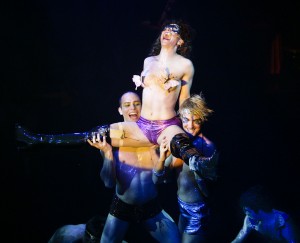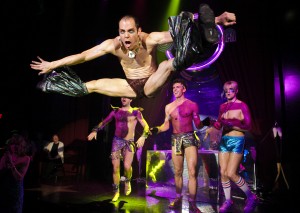Theater Review: The A.R.T. Shakes Its Ass
Observe the ass … his character is about perfect, he is the choicest spirit among all the humbler animals. — Mark Twain, “Pudd’nhead Wilson”
The Donkey Show Conceived by Randy Weiner. Directed by Diane Paulus and Randy Weiner. Presented by the American Repertory Theater at Zero Arrow Street, Cambridge, MA Presented by American Repertory Theater, at OBERON (Zero Arrow Theater), Cambridge, MA through January 9, 2010.
Reviewed by Bill Marx

Shakespeare in Disco Inferno: Tytania (Rebecca Whitehurst) carried by the fairies (Cameron Oro and Mike Heslin) Photo: Marcus Stern.
The notion that theater should be visceral and interactive isn’t new: back in the ‘30s Bertold Brecht famously asserted that theater should aim for crowd-friendly, live-or-die side-taking energy of a baseball game. But for Diane Paulus, the new artistic director of the American Repertory Theatre, the impression left by her fun (given your level of tolerance for disco, high-priced drinks, and Shakespearean kitsch) but silly debut production/disco dance party suggests that theater may not be at the center of her version of a theatrical event. At least this time around, drama turns out to be an attenuated side show at the circus.
Brecht the Marxist desires theater that galvanizes all ages. Paulus, programming in a balkanized American consumer culture, tailors her theater events for niche audiences. “The Donkey Show” is firmly aimed at a younger demographic that is into ‘70s retro: to my surprise, the audience knew the words to “YMCA.” No chance, however, that they will be exposed to any of Shakespeare’s poetry during the evening — there are no lines from the play while the plot has been sliced, diced, and snorted into an incoherent hash of sex, drugs, athletics, and supernatural doings at the Mafia-owned Club Oberon.
In “The Donkey Show” Shakespeare’s romance exists solely to provide opportunities for gymnastic eye candy. Sweaty, nimble, and buff, A.R.T. cast members jump, skitter, climb, cavort, and undulate among the dancing party goers; they scamper up and down the walls, platforms, tables, and stairs in the cabaret-ized Zero Arrow Theater. Their colorful costumes are skimpy and glittery; the lighting glaring.
The conga line of disco tunes, from “I Love the Nightlife’’ to “Never Knew Love Like This Before’’ provide jokey commentary on the dramatic action, such as it is. To my eyes, the audience’s attention drifted during the broad Bardic interludes: the young’uns were patiently waiting for the next classic boody-shaking song to spin. And who could blame them? The Bard has a snow ball’s chance in Paulus’s “Disco Inferno.”
Still, watching the pleasure-seeking mob of twentysomethings boogying away, flirting with the performers and practicing pick-up lines is a refreshing sight given the diminishing army of Gray Panthers who usually attend the theater. And for those oldsters who survived the disco period it was amusing to hear the tunes and even shake an antique groove thing.

Fairies on Fire: Cob Web struts his stuff... (Cameron Oro, Eric Johnson, Tom Fish, Mike Heslin). Photo: Marcus Stern.
Beyond saying that the experience was galvanic but empty, Paulus and Weiner’s dance-a-thon disarms criticism. The A.R.T cast members execute lots of gender bending and wild pantomime during the evening but the event isn’t about calibrated comic performances but the art of hyper-shaking a leg.
The ideal evaluators of “The Donkey Show” would be an “expert” panel inspired by Reality-TV shows such as “So You Think You Can Dance,” with numerical scores for the best hoofers. For me, the quartet of male fairies (Mike Heslin, Cameron Oro, Tom Fish, and Eric Johnson) stole the show, flipping and flopping with the maximum of personality. They had no dramatic role to play so they had the most freedom to do their own thing.
The challenge for Paulus is that, once she pulls in the young, will she provide anything provocative and dramatic for them or for the rest of us?
The with-it “Boston Globe” reviewer argues that some of the darker elements elements in Shakespeare’s play are on display but I don’t see them amid the campy exhibitionism. Yes, cocaine is used for nefarious sexual purposes and there’s an imaginatively stylized image of woman-on-donkey action. But the illicit is treated as just another giddy part of the cartoon antics, a funky parody of chic “bad” behavior. How disturbing can a show be that advertises in its program that it is not just entertainment but a potential franchise (“The Blue Donkey Show”?), available to perk up “birthdays, girls’ nights out, bachelorette parties, corporate events, and more.” (What about Bat Mitzvahs?)
The most intriguing part of “The Donkey Show” is that, even though it claims to be a nostalgic homage to the outré hedonism of the ‘70s, it was first produced in 1999, its success in New York and around the world paralleling the rise and fall of the Bush Administration, the cheerleader for the deregulated economic excess and shop-till-your-credit-card-dies mania that has led to the current worldwide financial blow out. In this sense the show reflects rather than examines the party-on-to-disaster spirit of the time.
Of course, Shakespeare knew that living “la vida loca” could only last for so long: during the final speech in “A Midsummer Night’s Dream” Puck returns the delighted if chastened audience to reality (“That you have but slumb’ red here/ While these visions did appear”). But Paulus and “The Donkey Show” don’t want the good times to stop: “Don’t let the party end when the DJ stops spinning. Share your pics and videos on our fan page” proclaims the program. It will be fascinating to see when the belly flop into escapism ends and contact with reality begins in Paulus’s populist dreams.
Tagged: American-Repertory-Theatre, Diane Paulus, Disco, Persona Non Grata, Randy Weiner, The Donkey Show

HI BIll,
Nice reflection on this first time out for ART. The more I heard about the approach, the more I wondered if anything would be left from the original show, and how it would play these days.